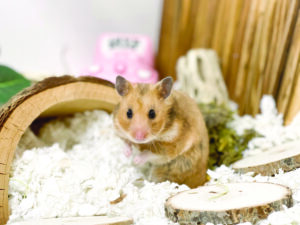By Dr. Beth Leermakers
More than half (57 percent) of American homes have at least one pet. Not surprisingly, dogs and cats are the most popular pets, with 76 million pet dogs living in 48 million households. According to the American Veterinary Medical Association, 58 million cats live in 31 million households.

Photo courtesy of Healthy-Pet.com
Hamsters are No. 8 on the list, with 887 out of 1000 households owning hamsters. How much do you know about these popular little critters?
1) How long do hamsters live?
a) 6-12 months
b) 12-18 months
c) 18-36 months
d) 5+ years
2) Which is NOT a hamster species?
a) Golden or Syrian
b) Snow white dwarf
c) Winter white dwarf
d) Campbell’s dwarf
3) True or False? Hamsters prefer to share their cage with another hamster.
4) True or False? Hamsters are most active during the day.
5) What feature sets hamsters apart from other rodent species?
a) Their teeth never stop growing.
b) Hamsters have longer tails than mice.
c) Hamsters have better eyesight than most rodents.
d) They have scent glands on their hips.
6) True or False? Hamsters are banned in Hawaii.
7) True or False? Hamsters can catch the flu and COVID-19 from people.
8) True or False? People can catch some diseases from hamster.
9) Which of these statements about the differences between guinea pigs and hamsters is FALSE:
a) Guinea pigs need to live with another guinea pig, while hamsters need to live alone.
b) Hamsters enjoy a running wheel, but guinea pigs do not.
c) Guinea pigs are easier to care for than hamsters.
10) True or False? Hamsters can carry a lot of food (half their body weight) in their cheeks.
Answers:
1. C. On average, hamsters live about 18-36 months, with Syrian hamsters more likely to live longer than dwarf varieties. Hamsters that are a year and a half old are considered elderly. Because they are short lived, they move through their lifespan quickly, reaching sexual maturity at 4-6 weeks.
2. B. Hamsters are rodents that belong to the family Cricetidae, which includes voles and lemmings as well as rats and mice. There are more than 20 hamster species. The most popular species for pets are the golden or Syrian hamster and three dwarf hamsters: the winter white dwarf, Campbell’s dwarf and Roborovski hamster, the smallest of all hamster species.
3. False. Hamsters should be housed alone. Unlike guinea pigs who are social creatures and need at least one buddy, hamsters are fiercely territorial and will fight and injure each other.
4. False. Hamsters are nocturnal creatures. They are easily frightened if you wake them up suddenly. Hamsters will nip when they are scared or poorly socialized, so they do not make good pets for young children.
5. D. Hamsters have raised, pigmented scent glands on their hips that may look like hair loss or tumors. Hamsters use these glands to communicate with each other, mark their territory and find their way back to their burrow.
You should have these glands checked by your veterinarian if they are not symmetrical. Like all rodents, hamsters’ incisors have no roots, never stop growing and contain active stem cells. Scientists hope to be able to replicate the tooth regeneration process in people. Hamsters’ eyesight is poor. They are practically blind in bright light and, even in dim light, can’t see much beyond the end of their nose. You should speak to them before picking them up, to avoid startling them.
6. True. Hawaii’s climate is similar to hamsters’ native habitat, so they would thrive in the wild. Hamsters reproduce at high rates. They have multiple mates, and females give birth to two to four litters per year, with up to 13 babies per litter (the average litter is 5-7). If hamsters escaped into the wild, they could quickly establish large colonies, threatening agriculture and native species.
7. True. Hamsters can acquire diseases, including the influenza and COVID-19 viruses, from people. If you are sick, avoid handling your hamster.
8. True. Some hamster diseases are zoonotic, meaning they can spread to humans. Talk with your veterinarian and doctor if you are concerned about a zoonotic disease, including but not limited to leptospirosis (also affects dogs), dermatophytosis (ringworm) Salmonellosis and other viruses.
9. C. Hamsters are relatively easy to care for. Guinea pigs have special dietary needs (including vitamin C supplements) and are often harder to care for than cats and dogs.
10. False. Hamsters are food hoarders who can carry fruit, grains, roots and leaves in their cheeks — up to an amount equal to their own body weight. Their name comes from the German word “hamstern,” which means to forage. In addition to toting food, Hamsters’ cheeks serve as life jackets. They fill up with air, allowing hamsters to float in water.
